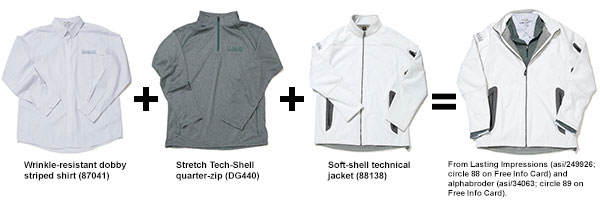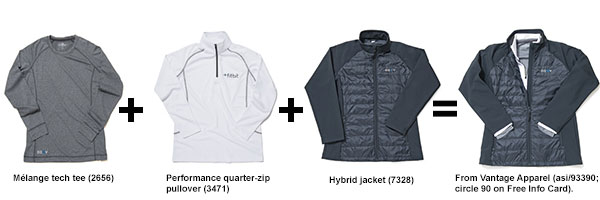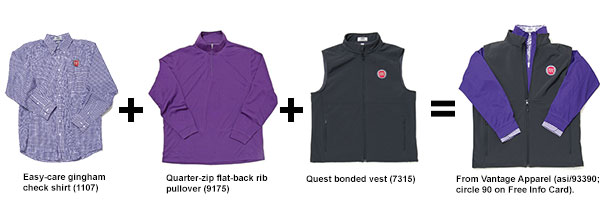Product Hub September 09, 2015
All Together Now
Double the sales and twice the versatility? Just look to the rising demand for layered looks.
Double the sales and twice the versatility? Just look to the rising demand for layered looks.
Consider the dedicated volunteer, who welcomes visitors to the Chamber of Commerce’s annual 5K, while alternately freezing or roasting, even both in a single day. One year, it’s in the upper 70s with a baking sun; the next, the thermometer hovers in the low 40s. Surely that basic cotton T-shirt giveaway won’t get the job done.
The best solution? A functional outfit which consists of a crew-neck tee as a base layer, a quarter-zip mid-layer and a water-resistant, hooded shell layer, all branded with the event and Chamber logos on the back and left chest. Wearers get much-needed versatility with the changing temperatures by the year – even by the hour.
The phenomenon at work is called layering, and it’s earning the spotlight precisely for this kind of application – granting the wishes of wearers who want versatility, flexibility, comfort and freedom of movement for different settings and activities. “The layered style of dress involves multiple garments worn at the same time,” says Danny Tsai, vice president of merchandising at Tri-Mountain (asi/92125). “It allows the wearer to make adjustments based on changes in temperature, weather and activity.”
Suppliers, recognizing the value and demand for layered items, now offer myriad options, including long-sleeve tees, quarter-zips, vests and soft-shells. “People want comfort and freedom of movement, and layering offers that,” says Gina Barreca, director of marketing at Vantage Apparel (asi/93390). “You can go with a more formal look, like a quilted vest under a dress coat, or more casual and activewear-inspired, such as performance tees paired with quarter-zips.”
In the promotional space, layered programs offer an intrinsic benefit: Several complementary pieces, each one embellished with the client’s logo, have the potential to increase impressions tremendously.
By Popular Demand
Anytime one garment is worn on top of another, it can be considered layering. But the notion as it applies to industry is something more purposeful: pairing garments that give the wearer flexibility, no matter the situation.
Elson Yeung, director of private label design & merchandising at alphabroder (asi/34063), sees the most practical applications in “functional layering.” “Layering for warmth includes fleece and insulated pieces,” he explains, “whereas layering for climates involves water-resistant or waterproof outer layers. We’ve seen huge momentum behind layering as three-piece suits have resurfaced, and pro golfers regularly layer on the course.”
Trends in retail strongly influence promotional styles, so it makes sense that this also includes apparel suitable for layering. “Layering is big at retail because it caters to different temperatures, climate changes and unpredictable weather,” Barreca says. “If it’s going to warm up, you want items that will take you through the day. People want thin, lightweight fabrics so they can be worn comfortably together.”
Lest it’s tempting to compartmentalize layering as a look only suitable for outdoor applications, consider professional layering for the office. “Workplaces now welcome a business casual style, as opposed to requiring suits and ties,” says Carla Dabiero, account executive at Lasting Impressions (asi/249926). “The right layered look allows the wearer to look professional, yet keeps them stylish and comfortable.”
In addition to style, versatility and comfort, layered branded items add yet another advantage: increased impressions with multiple logo locations. “We look at layering as an opportunity to add some fashionable choices for our customers,” says Ashley Mauldin, key account executive/outside sales at The Icebox (asi/229395). “We’re giving them additional opportunities to promote their brand.”
“Layering is going to play a role in almost every presentation we do this year.”
Gina Barreca, Vantage Apparel (asi/93390)
Take Your Pick
An ideal layering program features functional pieces that complement each other, whether it’s for booth staff at an indoor tradeshow or an outdoor 5K. “A good base layer, especially for sports, is a polyester moisture-wicking compression top,” Tsai says. “It wicks perspiration away from the skin, so the wearer stays drier and the shirt dries faster afterwards.” Tsai adds that an insulating layer, such as a mid-weight microfleece jacket, is often placed on top of the base layer, because “they’re lightweight, breathable and insulate even when wet. Finish it off with a lightweight shell layer that protects from wind and water.”
Quilted vests and jackets in particular are coming into their own as a prevalent choice for layering. “They’re great as either an under- or overlayer,” Barreca says, “and they’re often packable. Consider the younger generation for performance pieces, because they don’t do jackets anymore. They prefer a long-sleeve shirt with a sweatshirt. Activewear-inspired looks have really changed things.”
When a corporate team is in the market for a trade show or sales meeting ensemble, think quality easy-care items with fitted silhouettes. “Some of the most popular garments for a business casual look are quarter-zips with an open-collar button-down underneath,” Dabiero explains. “Often, it’s finished off with a tie. It transitions well from formal to business casual when the quarter-zip replaces a sport coat.”
If a client requires uniforms or employs multifunctional staff, they could potentially benefit from several-piece outfits as well. “Customers looking for uniforms often require a whole ensemble,” Yeung explains, “and companies often want options so their employees can represent the company at the office, in the warehouse or on the road. Insurance companies, for instance, have support staff, a sales force and claims adjusters who represent them in various settings.”
“We’re giving them additional opportunities to promote their brand.”
Ashley Mauldin, The Icebox (asi/229395)
The options for creating versatile layered outfits are legion, but the question remains: How much does a quality ensemble cost? Barreca approximates price using a popular example: a bonded vest paired with either a plaid woven or a quarter-zip. “The estimated cost for two of these three pieces is around $48 net,” she says, “so the buyer pays about $96 for the outfit.” Another go-to combination is a quarter-zip under a compressible jacket, an estimated $65 for the decorator and $125 to $130 for the end-user. “In both situations, the price for two pieces is either a little less or equal to the cost of a bulky, heavier jacket, which can be around $150,” she says, “and the end-user ends up with double the items that they can also wear separately.”
Send a Message
The multiple garments that make up a layered outfit allow for several impressions with just one ensemble. “Ideally, each piece can be traded out at any time as needed,” Tsai says, “so it’s important to decorate every garment.”
With the number of possible placements, planning optimal embellishment locations can seem daunting. However, consider it an opportunity to keep the brand front-of-mind rather than a task to be feared. Yeung, for instance, recommends pairing a long-sleeve base layer with a vest, and decorating the sleeve and the vest’s left chest for double brand exposure. “It’s important to know how the garments will be used,” he adds. “For customer-facing staff, the traditional chest location is always a go-to. For a charity run, cross-back decoration helps identify support staff.”
Perhaps a construction client needs new on-the-job garments for their crews; Dabiero suggests a logoed T-shirt, zip sweatshirt embellished on the left chest, and bonded or quilted vest with a full-back logo. “An executive would benefit from a button-up with a logo on the collar or wrist, paired with a quarter-zip with the logo on the back yoke, sleeve or chest,” she adds. “You can’t pigeon-hole matching ensembles. It’s ideal for anyone looking to advertise a logo.”
As layering gains increased popularity, it’s becoming more important for decorators to distinguish themselves from the competition. “Anyone who wants to offer fashionable options, along with multiple brand opportunities, should be open to it,” Mauldin says. “I always try to think outside the box. Consider a ringspun cotton piece with a distressed screen print as the base layer, for instance.”
While layering offers the opportunity to show off a brand in unexpected places on a garment, it’s important to maintain balance. “People don’t want to feel like a billboard, unless it’s a sponsorship opportunity,” Barreca explains. “Consider a quarter-zip with a tonal etch on the sleeve underneath a vest with left-chest embroidery. You could also put left-chest embroidery on that quarter-zip so it’s branded twice. Make sure no logos are fighting for attention, but also that you’re not missing any branding opportunities.”
Make the Sale
You’ve pored over catalogs, finally selecting the perfect ensemble with logos in all the right places. Now, how to make the sale? Fortunately, it might not be as challenging as you think – as long as the presentation is planned strategically.
Once the wearer’s needs have been assessed and options chosen accordingly, make sure to impress the client by matching each layering piece to their brand. “There has to be color coordination and consistency, especially in corporate outfitting,” Yeung says. “This could be either matching colors to tie into the corporate logo, or creating a layered outfit with complementary colors to create a professional appearance.”
At the sales call, presentation can make the difference between wowing customers and missing the sale. If a decorator fears the client will balk at buying three items presented individually, Dabiero says, they should present them simultaneously. “The garments should look as if they’re meant to go together, and show off their company colors and logo,” she says. “Many suppliers have garment lines with similar colorblocking or palettes that can be paired together. These are great to present as one piece, or separately if necessary.”
Pitching one item at a time might prove overwhelming, says Barreca, who echoes Dabiero’s suggestion that compiling garments on a hanger is the best way to unveil an outfit. “You don’t want to show one at a time and then say, ‘Now, buy all three’,” she says. “When they’re together, buyers say, ‘Wow, I never would have thought of that’. Try to start with three and only go down if you have to. Remind them that two lightweight items might be about the same cost as one piece from the year before.”
As suppliers continue to expand the already wide breadth of potential layering items up for grabs, the versatility, functionality and affordability of ensembles, not to mention the multiple impressions per outfit, make layering a sure bet for distributors. “It’s everywhere right now,” says Barreca. “Layering is going to play a role in almost every presentation we do this year.”
Levels of Layering
We asked suppliers, decorators and distributors selling decorated apparel to give us examples of popular layered outfits. Here’s what they suggested:
Button-Down Shirt + Performance Quarter-Zip + Soft-Shell = Business Casual Officewear

Tech Tee + Twill Shirt + Fleece Jacket = Entertainment Event Staff Uniform

Tech Tee + Performance Quarter-Zip + Quilted Jacket = Sporting Event Staff Uniform

Button-Down Shirt + Performance Quarter-Zip + Soft-Shell Vest = Trade Show Ensemble

Sara Lavenduski is an assistant editor for Stitches. Contact her at slavenduski@asicentral.com and follow her on Twitter at @SaraLav_ASI.

Product Hub
Find the latest in quality products, must-know trends and fresh ideas for upcoming end-buyer campaigns.
